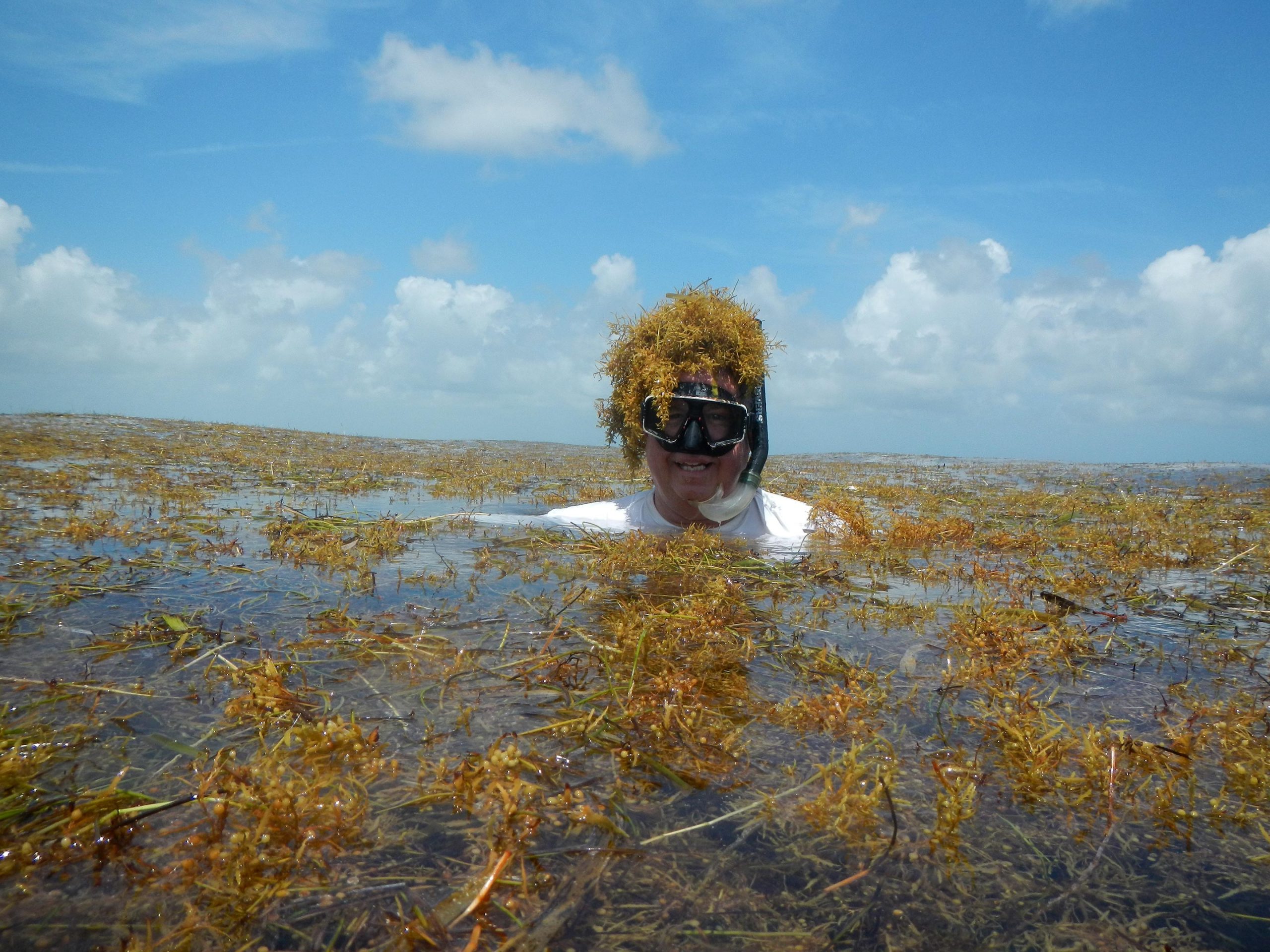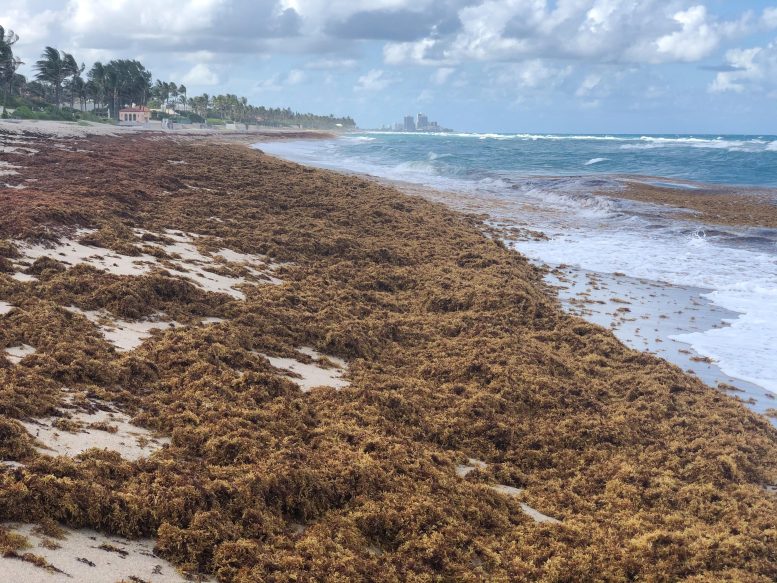Why Is a Floating Seaweed Taking Over an Entire Ocean? Researchers Have the Answer

Sargassum expansion across the Atlantic is tied to nutrient pollution and ocean circulation. Its growth now affects ecosystems and coastal communities.
Researchers at Florida Atlantic University’s Harbor Branch Oceanographic Institute have compiled a comprehensive review covering forty years of data on pelagic sargassum, the free-floating brown algae that plays a crucial role in the Atlantic Ocean.
For decades, scientists believed sargassum was largely restricted to the nutrient-poor waters of the Sargasso Sea. It is now clear that this seaweed has become a widespread and fast-growing presence across the Atlantic, with its expansion tied to both natural variability and human-driven nutrient inputs.
Published in the journal Harmful Algae, the review examines the emergence and persistence of the Great Atlantic Sargassum Belt, an enormous seasonal bloom that spans from West Africa to the Gulf of Mexico.
Since first being observed in 2011, this belt has formed nearly every year—except in 2013—and in May reached a record biomass of 37.5 million tons. This figure excludes the long-term background biomass of 7.3 million tons typically found in the Sargasso Sea.
Linking nutrient enrichment to sargassum expansion
The analysis integrates historical oceanographic records, modern satellite data, and detailed biogeochemical studies to better explain shifts in sargassum abundance, distribution, and nutrient balance. The findings emphasize the influence of human-driven nutrient loading on ocean processes and the urgent need for international collaboration to track and mitigate the impacts of these vast seaweed blooms.
“Our review takes a deep dive into the changing story of sargassum – how it’s growing, what’s fueling that growth, and why we’re seeing such a dramatic increase in biomass across the North Atlantic,” said Brian Lapointe, Ph.D., lead author and a research professor at FAU Harbor Branch. “By examining shifts in its nutrient composition – particularly nitrogen, phosphorus and carbon – and how those elements vary over time and space, we’re beginning to understand the larger environmental forces at play.”

At the start of the review, Brian Lapointe and his colleagues, Deanna F. Webber, research coordinator, and Rachel Brewton, Ph.D., assistant research professor at FAU Harbor Branch, note that early oceanographers mapped the Sargasso Sea by tracking surface patches of sargassum. They assumed the seaweed flourished in its warm, clear, yet nutrient-poor waters. This idea later presented a paradox, as mid-20th-century researchers went on to describe the same region as a “biological desert.”
Resolving the paradox with modern studies
However, recent satellite observations, ocean circulation models, and field studies have resolved this paradox by tracing the seasonal transport of sargassum from nutrient-rich coastal areas, particularly the western Gulf of America, to the open ocean via the Loop Current and Gulf Stream. These findings support early theories by explorers who proposed that Gulf-originating sargassum could feed populations in the Sargasso Sea.
Remote sensing technology played a pivotal role in these discoveries. In 2004 and 2005, satellites captured extensive sargassum windrows – long, narrow lines or bands of floating sargassum – in the western Gulf of America, a region experiencing increased nutrient loads from river systems such as the Mississippi and Atchafalaya.
“These nutrient-rich waters fueled high biomass events along the Gulf Coast, resulting in mass strandings, costly beach cleanups, and even the emergency shutdown of a Florida nuclear power plant in 1991,” Lapointe said. “A major focus of our review is the elemental composition of sargassum tissue and how it has changed over time.”
Growth rates and limiting nutrients
Laboratory experiments and field research dating back to the 1980s confirmed that sargassum grows more quickly and is more productive in nutrient-enriched neritic waters than in the oligotrophic waters of the open ocean. Controlled studies revealed that the two primary species, sargassum natans and sargassum fluitans, can double their biomass in just 11 days under optimal conditions. These studies also established that phosphorus is often the primary limiting nutrient for growth, although nitrogen also plays a critical role.
From the 1980s to the 2020s, the nitrogen content of sargassum increased by more than 50%, while phosphorus content decreased slightly, leading to a sharp rise in the nitrogen-to-phosphorus (N:P) ratio.
The story of sargassum over four decades. Credit: Brian Lapointe, FAU Harbor Branch
“These changes reflect a shift away from natural oceanic nutrient sources like upwelling and vertical mixing, and toward land-based inputs such as agricultural runoff, wastewater discharge, and atmospheric deposition,” said Lapointe. “Carbon levels in sargassum also rose, contributing to changes in overall stoichiometry and further highlighting the impact of external nutrient loading on marine primary producers.”
The review also explores how nutrient recycling within sargassum windrows, including excretion by associated marine organisms and microbial breakdown of organic matter, can sustain growth in nutrient-poor environments. This micro-scale recycling is critical in maintaining sargassum populations in parts of the ocean that would otherwise not support high levels of productivity.
Influence of Amazon River outflow
Data from sargassum collected near the Amazon River mouth support the hypothesis that nutrient outflows from this major river contribute significantly to the development of the GASB. Variations in sargassum biomass have been linked to flood and drought cycles in the Amazon basin, further connecting land-based nutrient inputs to the open ocean.
The formation of the GASB appears to have been seeded by an extreme atmospheric event – the negative phase of the North Atlantic Oscillation in 2009 to 2010, which may have helped shift surface waters and sargassum from the Sargasso Sea southward into the tropical Atlantic.
However, the researchers caution that there is no direct evidence of this movement. Moreover, genetic and morphological data suggest that some sargassum populations, particularly the dominant S. natans var. wingei, were already present in the tropical Atlantic prior to 2011, indicating that this region may have had an overlooked role in the early development of the GASB.
“The expansion of sargassum isn’t just an ecological curiosity – it has real impacts on coastal communities. The massive blooms can clog beaches, affect fisheries and tourism, and pose health risks,” said Lapointe. “Understanding why sargassum is growing so much is crucial for managing these impacts. Our review helps to connect the dots between land-based nutrient pollution, ocean circulation, and the unprecedented expansion of sargassum across an entire ocean basin.”
Reference: “Productivity, growth, and biogeochemistry of pelagic Sargassum in a changing world” by Brian E. Lapointe, Deanna F. Webber and Rachel A. Brewton, 8 August 2025, Harmful Algae.
DOI: 10.1016/j.hal.2025.102940
This work was funded by the Florida Department of Emergency Management, United States Environmental Protection Agency, South Florida Program Project, and the NOAA Monitoring and Event Response for Harmful Algal Blooms program. Historical studies included within the review were funded by the NASA Ocean Biology and Biogeochemistry Program and Ecological Forecast Program, NOAA RESTORE Science Program, National Science Foundation, “Save Our Seas” Specialty License Plate and discretionary funds, granted through the Harbor Branch Oceanographic Institute Foundation, and a Red Wright Fellowship from the Bermuda Biological Station.
Never miss a breakthrough: Join the SciTechDaily newsletter.
Source link

